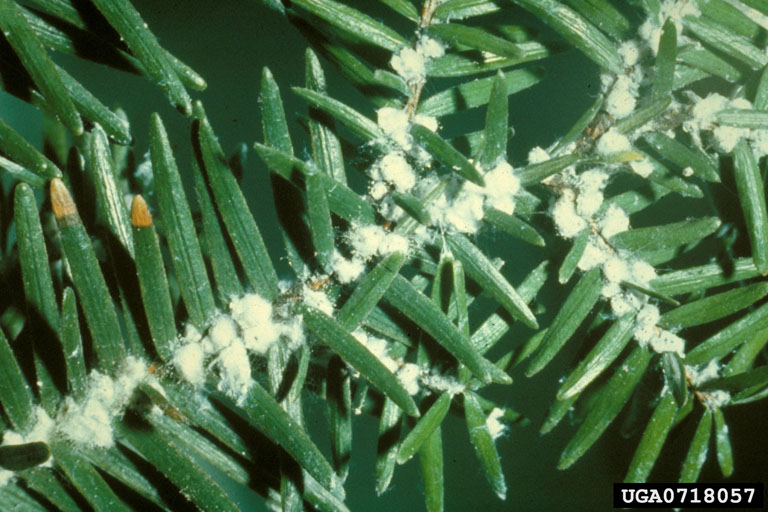Hemlock wooly adelgid is a small, aphidlike insect that is native to southern Japan. It was first discovered in North America in the early 1950’s near Richmond, Virginia. In the eastern United States, it has established itself as a common invasive pest that is endangering the sustainability of eastern hemlock and Carolina hemlock.
Hosts:
Hemlock wooly adelgid can develop and reproduce on any species of hemlock, but eastern hemlock and Carolina hemlock are the most vulnerable to infestation. Eastern hemlock, which is also called Canada hemlock or hemlock spruce, is a tree commonly used for ornamental planting. Its native range extends from large regions of Canada to the Central and Eastern United States. In Canada, it can be found across south-central Ontario, southern Quebec, New Brunswick, and all of Nova Scotia. In the United States, it grows throughout much of New England, New York, Pennsylvania, and the middle Atlantic States. Outliers appear in parts of northeastern Minnesota, western Wisconsin, southern Michigan, and western Ohio. Carolina hemlock has a more limited distribution. It can be found along the slopes of the Appalachian Mountains, ranging from Virginia and West Virginia to North Carolina, South Carolina, and northern Georgia.
Appearance:
Hemlock wooly adelgid has a distinct appearance. Fully matured adults are less than 1/16 of an inch in size, and have a dark ruddy exterior that varies between reddish-brown and purplish-black in color. Hemlock wooly adelgid is named for the wax filaments the insect produces to protect itself and its eggs from predators. These wax filaments, which are called the ovisac, resemble small tufts of cotton, and can be observed clinging to the underside of hemlock branches.
Lifecycle:
Hemlock wooly adelgid are parthenogenic. This means that all individuals are female and reproduce asexually. They complete two generations each year: a spring generation, and a winter generation. The spring generation, called the progrediens, develops from spring to early summer, a process that occurs over a period of four months (March-June). The winter generation, called the sistens, develops over a longer period of time, occuring for around ten months (June-March), and lasting from early summer to midspring of the following year.
In the hot summer months, adelgid enter a period of dormancy during which their nymphs are enveloped in a protective sphere of wooly wax that surrounds their bodies, and shields them from predators. Adelgid become active again as the summer temperature wanes, and cooler weather prevails. They begin to feed during the fall months, and continue to persist throughout the winter.
Adelgid go through six stages of development: the egg, and four nymphal instars, before finally maturing into adults. Once they have hatched from their eggs, the first instar nymphs, called crawlers, begin scouring the hemlock for potential feeding sites. When they have found a suitable location, they settle there for the remainder of their development, and begin to feast on young twig tissue.
Impact on Trees:
Adelgid feed on the starch reserves that are critical to a hemlock’s growth. As the insect drains the hemlock’s reserves, it causes the tree to decline, resulting in its failure. Additional stressors such as drought, poor soil conditions, and the presence of other insects or diseases can accelerate a hemlock’s decline.
Prevention & Management:
There are a number of control methods that can help prevent the spread of adelgid, and protect individual trees from infestation. Adelgid are often dispersed as a result of the elements, or from coming into contact with animals such as birds or deer. As such, bird feeders should be kept safely away from healthy or infested hemlocks.
Chemical treatments, such as foliar sprays, or systemic insecticides, have proven to be effective at treating individual trees in nonenvironmentally sensitive areas. Systemic insecticides can either be applied to the soil around the base of the tree, or injected directly into the stem. Chemical treatments serve as a short term solution, and need to be applied repeatedly over time in order to maintain their efficacy.
Another control method is more biological in nature, and involves the introduction of predators and pathogens that feed exclusively on adelgid. As these predators become established in the infested area, they can help offset the spread of adelgid, and reduce its population.
Photo courtesy of USDA Forest Service.
